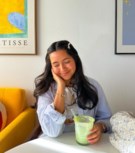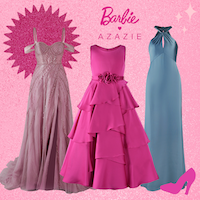LIFE
Snag That Dream Job: I wanna...be a killer whale trainer!
What do you wanna be when you grow up? GL recently had the chance to go to SeaWorld, Busch Gardens and Discovery Cove in Florida to interview peeps with some of the most coveted jobs in the world (dolphin trainers, roller coaster engineers, animal pathologists and more!).

What's the first thing that pops into your mind when you think of SeaWorld? It's probably killer whales and Shamu, right? Well, I had the chance to attend SeaWorld's new killer whale show Believe AND I got to interview a killer whale trainer afterwards.
The show was breathtaking. The performance followed the story of a young boy's relationship with a killer whale and included tons of cool stuff, plus lots of audience interactions (so fun!). We got to see tons of jumps, flips and dips and of course, we got splashed by the whales' big tails (yep! There's a "Soak Zone" where peeps who don't mind getting wet sit). One of the most amazing parts was the interaction between the trainers and the whales. To see a trainer and whale dance is pretty amazing—I'm mean c'mon they're on water, doing these amazing ballet moves AND they're on the fin of a killer whale? Amazing! (Especially since I'm uh, not the world's most coordinated person myself!)

Shana: I personally have a biology and a chemistry degree. I grew up in Michigan. I came down to Florida, right after I graduated. Got an internship working with whale dolphins humanities for six months. I came here right after that and I’ve been at SeaWorld for eight years.
GL: And I've heard that it takes about three years for you to even get in the water with the whales?
Shana: I worked at with whales and dolphins for a year, then I went to sea lion otter for three years and then I came here, so coming here I was already a senior trainer. It was one year of getting to know the whales and building a relationship with them.
When you’re in the water with them, at the top part of the ocean and they all have those natural instincts. They truly are different with people that they do not know. It’s no different than it is with people.
You know, a lot of people ask can we touch the whales and what not? And I’m like, it’s really no different than somebody not knowing you coming up and touching your hair or something like that. The whales react in the same way and so I spent that year just building a relationship and getting to know them. And I would pick, I would figure out who their favorite trainers were and hang out with those trainers.
GL: So what do you think the hardest part of building the relationship is?
Shana: Figuring out what they do and don’t like. And having them respond to you. And [having them] see you differently than what they see everybody else. For instance, the whale that I started working with from the get-go was Katina and I was a senior trainer. I knew exactly what I was doing and she wanted nothing to do with me.
And then her favorite trainer, Liz would come up and she would be all excited to see Liz. You could see the difference in her personality, as soon as Liz would walk by.

Shana: And so it was a challenge for me to figure out what I needed to do to get this whale to respond to me. That was the biggest challenge and I just needed to find out exactly what she liked and exactly what she didn’t particularly like. And apply those things so she could get to know me. It just takes times, just like people
GL: Tell us a little bit about the internship program that you have here with the killer whales. What does that involve?
Shana: It’s a great program. Right now we have about 20 to 25 students from, mainly from right here in Central Florida, UCF and Lexi community college, is the majority of our students. But they actually come from all over the U.S.. But, they come and they are able to stand poolside and do whale watch and watch their behavior. They are doing data collection on the rotational behaviors of killer whales. The left and right handedness of them. Do they have left and right handedness to them like we do?
While they are standing poolside, it’s a great opportunity for them to see a little bit of a glimpse into our lives outside of the shows. Our shows are very glamorous and it shows the glamorous side of our jobs. But there’s also the side of the job that is the bucket scrubbing, the floor scrubbing, the pool scrubbing and also the training side as well. So it’s a really great opportunity for the students that want to get into this kind of career as an animal trainer, or even as a veterinarian, they can come see the kind of things that we do.
GL: Cool! So, when did you decide that you wanted to do this?
Shana: I was really young and the first animal that I fell in love with was a manatee. It was really the first marine mammal that I saw in person. I was down here visiting my grandparents and I don’t know what it was about that animal, I just wanted to save the manatees. I saved up all my allowance and sent it into the Save the Manatee Foundation. But I had a love for animals right from the get-go. It was just something inside that I knew that I had to do.
GL: Very cool. How much of your day is spent doing shows and then how much is spent training and all that other stuff?
Shana: Depends on the time of year. Summer, for example, we do show after show after show. We are here for about 12 hours, individually, every one of us. Really our day starts at 6 a.m .and doesn’t end 'til 11 p.m. During the summer we do seven shows a day plus we have interaction programs with Shamu, so we are go, go, go, all the time. In the summer it is nothing but show.
Now, right now, we have two to three shows a day, so we’ll do a show and then we’ll spend all afternoon training new staff, training our employees, our new and upcoming trainers to get water work practice. Everything is practice, practice, practice. And, this is the time of year that we can take all of our trainers and develop our babies. We have three babies and they are all learning new things.
GL: What do you think is the funnest part of the job?
Shana: For me, a couple of things. Training is one of the funnest parts for me. To see the animals learning something new and to be so interested is great. I mean, you can really see the connection. They are watching you, you see their eye moving and watching your every move and trying to figure out what you are trying to communicate to them. And when you see the lightbulb come on and they get it, it is like no other feeling you will ever have. It’s really incredible and its very stimulating for them. They really enjoy it.
And the other aspect I love is the show. Dance has been a passion of mine and the ballet, is the segment that I did in the show. That’s me and my, the whale. I get to dance with killer whales. And that’s just, that’s my two passions combining into one. It is amazing to me.

Photo by Cait Rohan
GL: When you are introducing a new trick, what is that? I’m sure that it varies with the trick and the whale, but what is involved with that?
Shana: Well, the whale that just came over, Katina, I just started training her a brand new behavior. Its called the center back breech and it occurs in the center of the pool. You may have seen it during the show. But it’s a big back breech behavior in the center of the pool, and she’s 30-years-old and not only has she been there done that, but she thinks she knows everything. So, its, it has been very challenging training this behavior. It’s been, probably about a year and a half and last week I got it in the show for the first time. And I cant even tell you how great of an accomplishment that feels. And, it’s, she’s amazing. She’s very smart and it’s just a great, great feeling when you see it put like that.
GL: Wow, that’s awesome. What would you say to a young girl who wanted to get involved in this?
Shana: It’s amazing. It’s a great lifestyle. I love it. There’s a lot of sacrifice that goes along with the commitment to our lifestyle and our job. We work really late hours. We work every weekend and almost every holiday. So, there is a lot of sacrifice. We sacrifice our nails, our hair, even our skin to be able to be in wetsuits all day long. But, you know what, I wouldn’t change it for anything. It is amazing. It’s a passion, that when you have it inside of you. It just never ends.
What I like the most about my job is when I go away on vacation and I come back and I think to myself, I am so excited to be back. I am so excited to see the whales. I have been here for eight years and it still energizes me, it gets me going, I get excited, they get excited. They respond off my energy. And I come back, and I come back to a job that I love and that’s the best, best thing. And that’s what I tell so many students that I work with through the internship is, no matter what it is that you want to do, find your passion. What are you passionate about? Because no matter what you are passionate about, if you find that passion, your done. You are going to excel. You are going to succeed. No matter what because you have that inside of you. So if it’s something you have inside of you, go for it.
Shana: One thing as a trainer, when you get hired in, you have to take a swim test. So that’s one thing I talk to the students about, is what it takes to get into this position. And one of the hardest parts of that swim test is the underwater swim. It’s 120 feet under water without taking a breath of air. It’s very difficult. But for me, not only was that the hardest part, it ended up being my favorite part because the second I got to the end of the pool and touched that wall, it was a huge sense of accomplishment for me.
I do a lot of strength training. I do probably four to five days of strength training a week. Lifting weights and lots and lots and lots of push-ups. To be able to stay strong, to have a strong upper body that’s one of the main things for us women in this career. And I also continuously challenge myself physically. I do yoga outside of work and run races and do lots of outdoors kind of things. But a lot of us trainers do that kind of stuff to just challenge ourselves physically and stay in that physical condition, because it’s really important for our jobs to not be injured.
GL: In addition to the physical aspects, what kind of schooling would you recommend for young girls?
Shana: For animal training specifically, I would recommend anything in the biology and psychology field. It could be zoology, anything animal-related or psychology. Either way, a lot of us have various degrees, but that’s a good place to start. All of the interns that we have here are either in a biology or psychology program.
POSTED IN How to get a job

 become a contributor
become a contributor


















